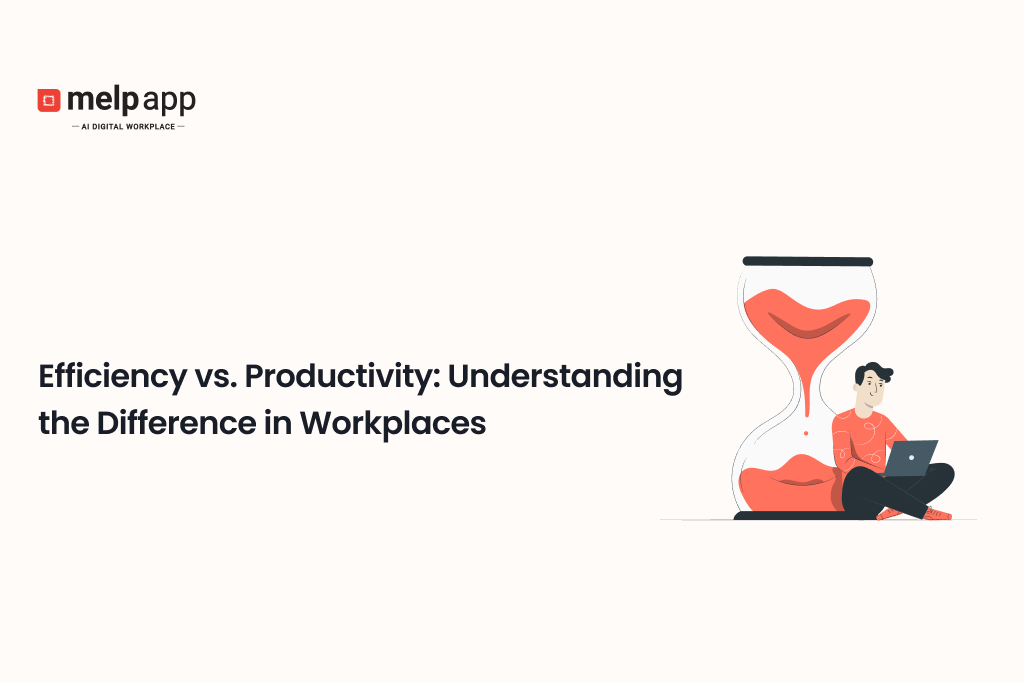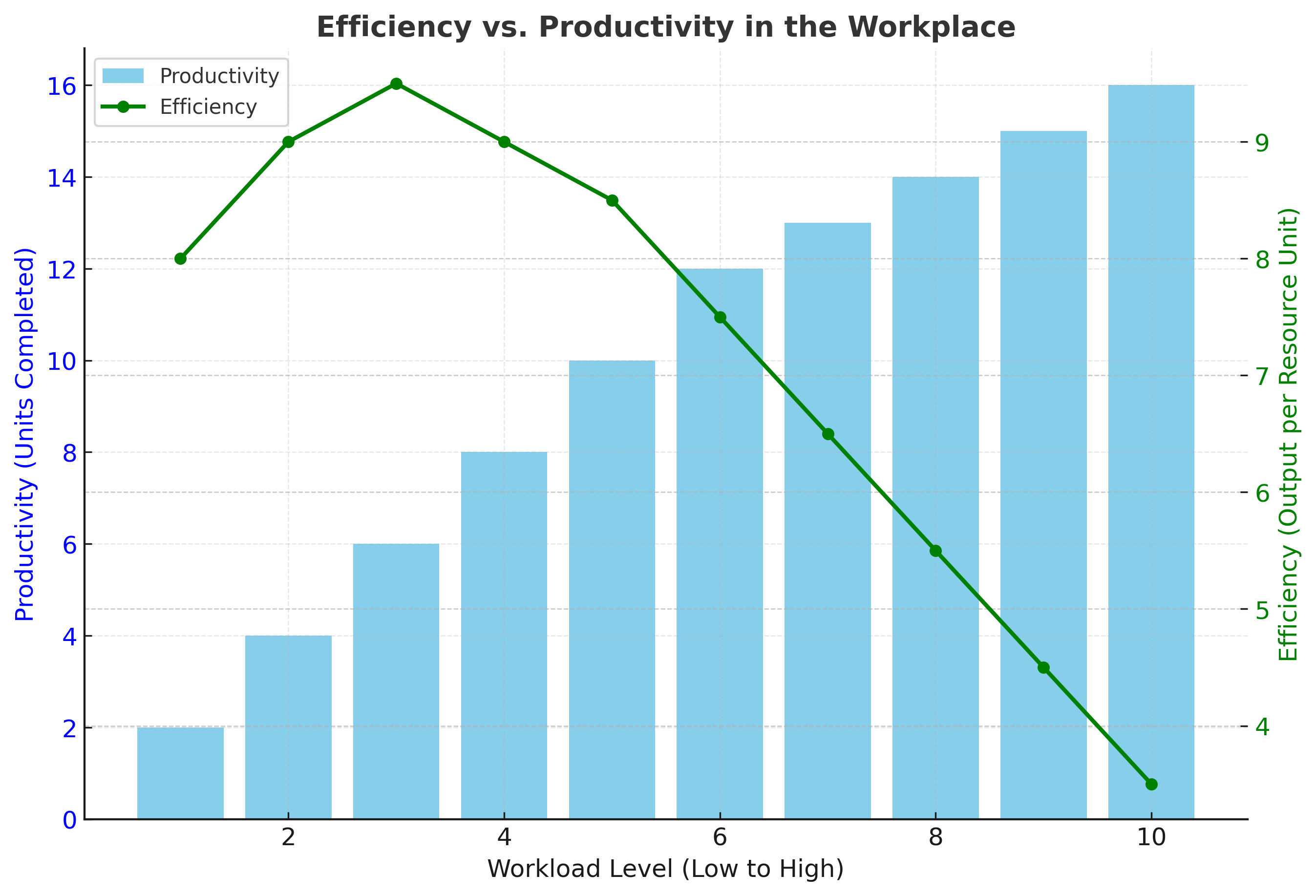
Introduction
In most workplaces, people often use efficiency and productivity as if they mean the same thing. At first glance, they look similar, but they’re not the same. Knowing the Difference between efficiency and productivity helps teams and leaders set better goals, improve performance, and build a healthier work culture. When these ideas get mixed up, it can lead to unrealistic expectations, burnout, and missed opportunities.
Efficiency focuses on doing the work in a smart way, with fewer steps, less waste, and the right effort for the result. Productivity focuses on how much work is completed in a given time, whether it is measured in hours, days, or weeks. When both are understood clearly, leaders can improve processes without pushing people past their limits.
Whether leading a large team or managing personal tasks, it helps to see how these two work together. Strong efficiency makes the process smoother, and productivity usually rises as a result. This clarity helps achieve better outcomes without sacrificing quality or employee well-being.
Understanding Efficiency
Efficiency is about using resources well to get a job done. In a workplace, those resources are time, money, tools, and people’s skills. A team is efficient when it reaches the goal with as little waste as possible while keeping quality high.
Think of a support team that answers 100 inquiries in a day with fewer staff and still earns excellent service ratings. That’s team efficiency. It’s not just about doing more. It’s about doing the work cleanly, with minimal waste.
How do companies raise efficiency? They plan processes better, pick the right tools, and remove steps that don’t add value. One caution, though. If everything is about efficiency all the time, it can squeeze out creativity and slow innovation.
.
Understanding Productivity
Productivity is about how much work gets done in a set amount of time. It measures output, not the resources used. Put simply, it answers the question, “How much did we finish?”
If a marketing team ships five strong campaigns in a month instead of three, that’s higher team productivity. The focus is on results. Leaders often raise productivity by improving skills, giving better tools, and keeping people motivated.
There’s a catch. Pushing productivity without looking at efficiency can drive up costs, waste time and effort, and leave people exhausted. That’s why productivity vs. efficiency shouldn’t be treated like a one‑sided contest. The best outcomes come when both move forward together.
Key Difference Between Efficiency and Productivity
The Difference between productivity and efficiency lies in focus. Productivity measures the amount of work completed over a given time, while efficiency measures how well resources are used to achieve that work. Both are important for workplace success, but they require different strategies and mindsets.
Think of it this way:
- Productivity is about producing more work in less time.
- Efficiency is about producing the same or better results with fewer resources.
For example, a sales team might close 50 deals in a month (high productivity), but if they spend twice the budget doing so, they are not being efficient. On the other hand, they might close 30 deals at a much lower cost with higher profit margins, showing strong efficiency but lower productivity.
The Difference between efficiency and productivity matters because improving one does not always improve the other. In some cases, a short-term productivity boost can harm efficiency if it requires overtime, extra spending, or rushed work that leads to errors.
Five Ways to Understand Productivity vs. Efficiency
Focus Area
- Productivity answers, “How much did we get done?” It’s about output — the number of tasks, projects, or units completed in a set time frame.
- Efficiency answers, “How well did we get it done?” It focuses on the process, cutting waste, and using time, money, and skills wisely.
- Example: A factory might double output by running machines nonstop (high productivity), but if maintenance costs spike, efficiency suffers.
Measurement
- Productivity is measured in raw counts: units produced, calls made, campaigns completed, or hours billed.
- Efficiency is measured by input-to-output ratios: how many hours, how much money, or how many people it took to achieve that output.
- Example: A marketing team delivering 10 social campaigns in a month shows high productivity. If they did it with fewer people, stayed under budget, and kept quality high, that’s strong efficiency.
Impact on Costs
- High productivity doesn’t automatically reduce costs; you can move faster and still waste money if processes are clunky.
- High efficiency tends to lower costs by removing unnecessary steps and optimizing resources.
- Example: A consultant taking on more clients (higher productivity) might need extra staff to meet deadlines, which can cut into profits.
Quality Consideration
- Productivity can rise while quality drops, as long as volume increases — risky where customer satisfaction or safety matters.
- Efficiency values quality and resource use together, ensuring standards are met without overspending time or budget.
- Example: A software team shipping weekly updates (high productivity) can still lose trust if those releases are buggy, showing why efficient development practices matter.
Sustainability Over Time
- Productivity pushes for speed and quick wins; without support, it can cause fatigue and churn.
- Efficiency supports long-term performance — steady results without burnout or waste.
- Example: A support team working heavy overtime to clear tickets (high productivity) may see turnover rise and response quality fall; smarter workflows, better tools, and balanced schedules keep results consistent.
These points show how productivity (how much) and efficiency (how well) work together. Aim for both: clear output goals plus streamlined processes that protect quality and people.
How to Balance Both
Workplaces that understand efficiency vs. productivity know that long-term success comes from balancing the two, not favoring one over the other. When teams only chase higher output, they risk overspending, burning out, or lowering quality. When they only focus on resource optimization, they might miss growth opportunities. The right approach is to create a strategy where both goals support each other.
Practical ways to balance Efficiency and Productivity
Set clear goals for both
Leaders should track results and how those results are achieved. Measure output alongside resource use so one metric doesn’t dominate the other. For example, a sales team might aim to increase deals closed by 15% (productivity) while cutting customer acquisition cost by 10% (efficiency). This dual focus keeps growth aligned with business health.
Use the right tools
Well-chosen software ties team efficiency and team productivity together. Project boards, automated reports, and simple communication hubs keep work organized, reduce busywork, and speed up collaboration. The right tool trims extra steps while helping people finish more in the same amount of time.
Encourage skill development
Training improves both sides. Teaching better ways to handle tasks reduces errors and rework, which lifts efficiency. Cross‑training and new certifications expand what people can do, which boosts productivity. In fast‑moving teams, a well‑trained group adapts quickly without losing performance.
Avoid burnout
Chasing output without limits backfires. Overworked teams make more mistakes, waste time, and slow down. Managers should watch workload, rebalance tasks, and protect breaks. A steady pace keeps quality and morale high over the long run.
Measure and adjust regularly
Don’t “set and forget.” Review both productivity metrics and efficiency indicators on a regular cadence. If output is strong but costs creep up, shift attention to efficiency. If resources are tight but targets are missed, focus on lifting productivity. Small, timely adjustments keep the balance right.
In reality, workplace success happens when teams can deliver high-quality results without overusing resources or sacrificing well-being. Leaders who understand that both numbers and processes matter are the ones who create stable, thriving teams. Balancing these two forces is less about finding a perfect middle point and more about adjusting focus as business needs change.
Use the right tools
The right software connects team efficiency and team productivity practically. Project boards, automated reports, and simple communication hubs keep work organized, cut busywork, and make collaboration faster. A modern digital workplace platform brings these into one place so teams can manage tasks, share files, and track progress without bouncing between apps. The result is fewer steps, less confusion, and more work finished in the same amount of time.
Difference Between Productivity and Efficiency
| Aspect | Efficiency | Productivity |
|---|---|---|
| Definition | How well resources such as time, money, and skills are used to complete a task. | How much work or output is produced within a specific time frame? |
| Primary Focus | Quality of process and minimal waste. | Volume of work completed. |
| Measurement | Ratio of input to output (resources used per result). | Number of tasks, units, or projects completed over time. |
| Impact on Costs | Usually lowers costs by reducing waste and optimizing resources. | May increase costs if achieved through overuse of resources. |
| Quality Factor | Maintains or improves quality while minimizing resources. | It can increase even if quality drops, as long as more is produced. |
| Sustainability | Supports long-term performance without burnout. | May cause burnout if pursued without resource management. |
| Workplace Example | A support team answers 100 tickets using fewer agents and stays under budget. | A sales team closes 50 deals in a month regardless of extra spending or overtime. |
The graph shows why productivity and efficiency are not the same thing.

The bars reflect how much work gets finished, which is productivity. The line tracks efficiency, or how wisely time, energy, and effort are used. In the early stretch, both measures can climb together. As the workload stacks up, efficiency often slips even while the bar total keeps rising, since rushing brings errors, rework, and fatigue.
It’s a simple lesson: getting more done doesn’t always mean things are running smoothly.
The strongest results come from a balance. Teams finish work, use resources carefully, and keep stress under control. Leaders who watch both signals can assign work more thoughtfully, smooth handoffs and processes, and help people stay motivated and consistent over time.
Conclusion
Understanding Efficiency vs. Productivity isn’t just about definitions. It’s about using both ideas to solve real problems at work. Efficiency ensures that resources, such as time, budget, tools, and skills, are used wisely. Productivity makes sure goals are hit and results actually ship.
Focusing on only one can cause trouble over time. If all the attention goes to output, costs and burnout rise. If everything is about cutting steps, quality or innovation can stall. The sweet spot is finding the balance, working smarter as well as harder. When teams recognize the difference between productivity and efficiency, they can protect well-being while still improving performance.
When leaders and employees see how these two concepts support each other, processes get cleaner, results get better, and motivation lasts. In the end, success comes from treating efficiency and productivity as parts of the same strategy, not rivals.
Boost Your Workplace Balance with Melp
Balancing efficiency and productivity is what keeps teams strong over the long run. Melp helps by streamlining workflows, tightening communication, and keeping everyone aligned without cutting corners on quality.
With Melp, teams can:
- Keep updates, tasks, and files in one place so work moves faster with fewer mix-ups.
- Organize conversations by topic or project to reduce noise and make decisions quickly.
- Meet over audio or video when needed, then jump back into focused work without switching tools.
Whether leading a growing team or running day-to-day operations, the right platform makes a real difference. Sign up for Melp today and start building a smarter, more productive workplace.